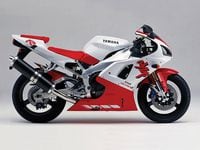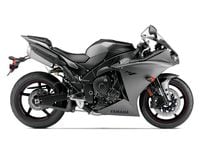Sportbikes evolve faster than the unexpected dinner guest from Alien, resulting in faster, lighter, and more menacing models every few years. But far from going quietly extinct, the ancestors of today's cutting-edge models still prowl the back roads and go hunting on trackdays. And while they're no longer the top predator in the power-to-weight jungle, some rule in bang-for-the-buck territory. One such example is the first-generation Yamaha YZF-R1, a beast when it debuted in 1998 and still surprisingly sharp-clawed and red-eyed today.
By the mid-1990s Honda's CBR900RR ruled the literbike roost. Yamaha's last entry in the class, the FZR1000, had been dropped in 1994, replaced as top dog in its sporting lineup by the FZR750. That bike's five-valve Genesis engine, which had debuted in the FZ750 way back in 1985, got its first major redesign for use in the R1. The most notable upgrade was a transmission with the two gearbox shafts stacked vertically rather than one in front of the other. The goal was a shorter, more compact engine that could be positioned in the frame for better mass centralization and permitted a longer swingarm for better handling without increasing the wheelbase.
One holdover from the FZR1000 was the EXUP valve in the exhaust system that boosted midrange without restricting top-end power. Abetted by a quartet of 40mm carbs, the YZF-R1 spit out 140 hp and produced exceptional torque throughout the powerband. The chassis was graced with a 41mm inverted fork with 300mm semi-floating front discs, and the electronic instrument cluster incorporated fault-diagnosis settings as well as digital readouts. After minor updates in 2000, in ’02 the R1 got a major facelift, plus the addition of fuel injection, new high-silicon cylinder sleeves, and a Deltabox frame that improved rigidity by 30 percent.
A used first-gen R1 is still a raucous ride today. If the one you’re looking at doesn’t have a steering damper, you should probably put one on your wish list. Don’t be put off by a rough-sounding snarl from the engine on start-up—this is one of those times the old sellers’ excuse, “They all do that,” is probably true—but once it’s warm listen for the usual valve clatter, lower-end rod knock, and anything else that doesn’t sound right. Abundant torque down low means the EXUP is working; if it’s not you might as well go ahead and swap out the stock pipes for aftermarket, a mod many owners advocate.
The light, short, and powerful R1 can turn just about anybody into a wheelie king, so check the steering-head bearings for smooth, notch-free operation and watch for leaking fork seals. The fairing and other plastic parts are thinner than those on other bikes of the time, so look for cracks. Very early models were the subject of a clutch recall, and slipping out of second gear means splitting the cases to replace a detent spring. Other than checking the oil frequently, however, most are reliable and get by just fine with regularly scheduled attention.
Absolutely insane performer. In the right hands still a threat to modern sportbikes.
Getting hard to find a clean one. As a commonly beat-upon supersport, the R1 is prone to a hard life.
A fragile second gear, bad clutch, EXUP out to lunch.
Still crazy after all these years. The Saturday-night special of literbikes.
1998 / $2,795 1999 / $3,005 2000 / $3,250 2001 / $3,520 2002 / $3,855 2003 / $4,225
Yamaha advanced the R1 significantly for 2004, crafting a new aluminum Deltabox chassis to house a short-stroke variant of the 20-valve inline-four engine. Now 77 x 53.6mm, compared to 74 x 58mm, the R1’s bore and stroke indicated Yamaha’s desire to raise the rev ceiling and add copious horsepower. Underseat exhaust debuts here too.
For 2007, Yamaha reluctantly gave up on the Genesis five-valve combustion chamber for a more conventional four-valve setup. It also got a version of Yamaha’s ride-by-wire system with variable-length intake funnels and a slipper clutch. The chassis was further refined and modernized, with audacious six-piston radial-mount front calipers.
A five-year run for the groundbreaking Crossplane R1. Staggering the connecting rods at 90-degree angles made a four-cylinder engine sound like a twin and put down a mix of low-end torque and high-end horsepower that promised the best of both worlds. With switchable power modes from the start, traction control arrived in 2012.














/cloudfront-us-east-1.images.arcpublishing.com/octane/TNOU5DNE2BC57MFPMGN2EIDXAM.jpg)
/cloudfront-us-east-1.images.arcpublishing.com/octane/GTCXACQGJ5HAPDTGWUQKDEH44E.jpg)
/cloudfront-us-east-1.images.arcpublishing.com/octane/S35YGSEMEZB4BLTDJTSZPF4GLA.jpg)
/cloudfront-us-east-1.images.arcpublishing.com/octane/5UOT6HPX2JFMRJAX6EH45AR4MQ.jpg)
/cloudfront-us-east-1.images.arcpublishing.com/octane/OKWOJWAKP5EP3OACCRRWPCIX2Q.jpg)
/cloudfront-us-east-1.images.arcpublishing.com/octane/2WF3SCE3NFBQXLDNJM7KMXA45E.jpg)
/cloudfront-us-east-1.images.arcpublishing.com/octane/G4MG6OUCJNBSHIS2MVVOTPX65E.jpg)
/cloudfront-us-east-1.images.arcpublishing.com/octane/IIGGWFOTOJGB7DB6DGBXCCMTDY.jpg)
/cloudfront-us-east-1.images.arcpublishing.com/octane/QSTCM6AVEZA5JJBUXNIQ3DSOF4.jpg)
/cloudfront-us-east-1.images.arcpublishing.com/octane/U4I7G625B5DMLF2DVIJDFZVV6M.jpg)
/cloudfront-us-east-1.images.arcpublishing.com/octane/B6XD6LS6IVCQPIU6HXDJSM3FHY.jpg)
/cloudfront-us-east-1.images.arcpublishing.com/octane/ICL63FEDDRDTTMINYICCEYGMDA.jpg)
/cloudfront-us-east-1.images.arcpublishing.com/octane/FCGZHQXRBZFLBAPC5SDIQLVF4I.jpg)
/cloudfront-us-east-1.images.arcpublishing.com/octane/WNOB6LDOIFFHJKPSVIWDYUGOPM.jpg)

/cloudfront-us-east-1.images.arcpublishing.com/octane/X33NU3E525ECRHXLNUJN2FTRKI.jpg)
/cloudfront-us-east-1.images.arcpublishing.com/octane/6KKT5NNL2JAVBOXMZYS5ZO76YA.jpg)
/cloudfront-us-east-1.images.arcpublishing.com/octane/J5RKG5O455GMPGQRF2OG6LRT7A.jpg)
/cloudfront-us-east-1.images.arcpublishing.com/octane/GX2CIZKQVRH2TATDM26KFG2DAE.jpg)
/cloudfront-us-east-1.images.arcpublishing.com/octane/ZWIDYSAKQZHD5BHREMQILXJCGM.jpg)
/cloudfront-us-east-1.images.arcpublishing.com/octane/CYUHJZCTSJCH3MRAQEIKXK7SCQ.jpg)
/cloudfront-us-east-1.images.arcpublishing.com/octane/LKOFINY56FCXJCANJ5M7ZDQUBY.jpg)
/cloudfront-us-east-1.images.arcpublishing.com/octane/4NBPDACMWJH63JQYJVK3QRBDZI.jpg)
/cloudfront-us-east-1.images.arcpublishing.com/octane/KKHQHRR3FJGX7H2IPU6RALMWG4.jpg)